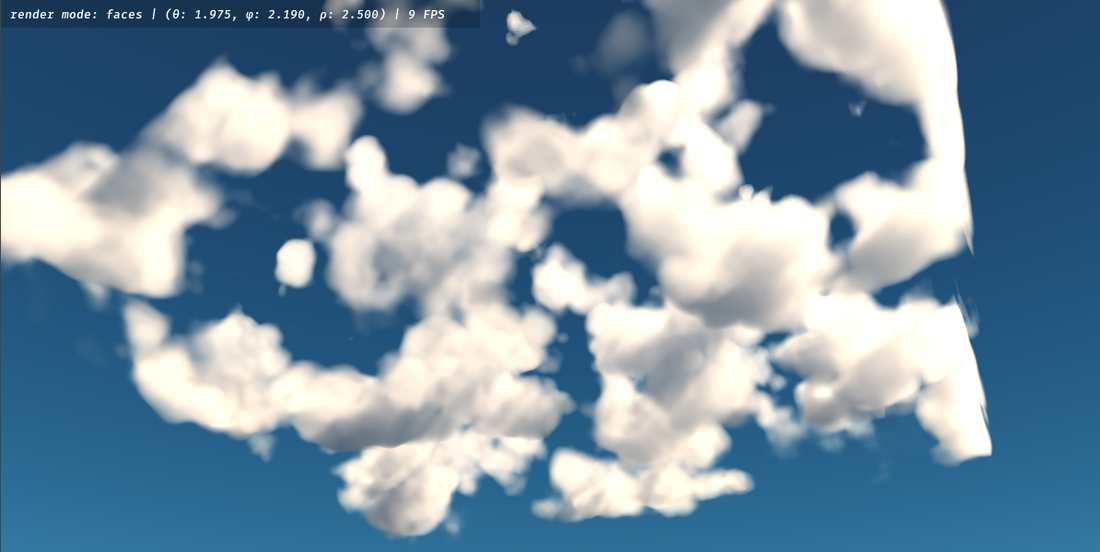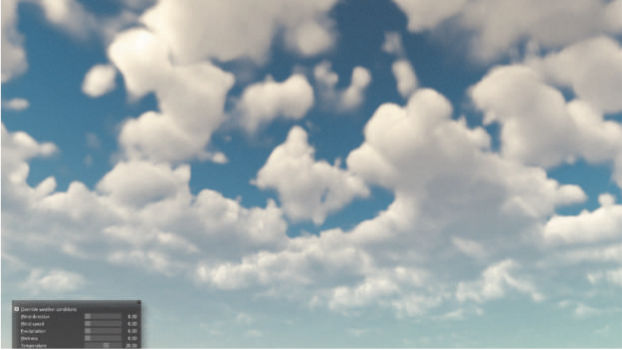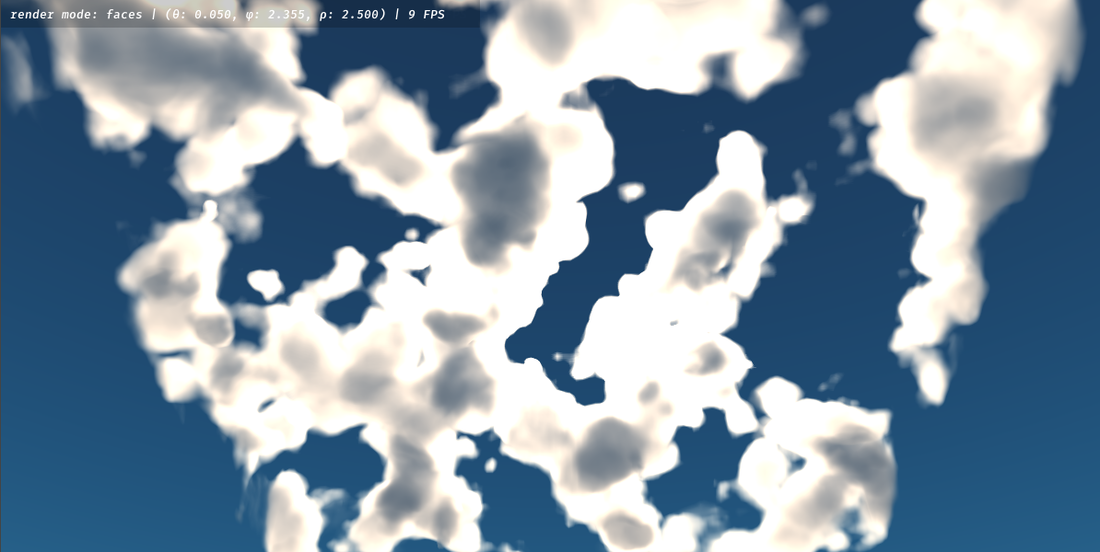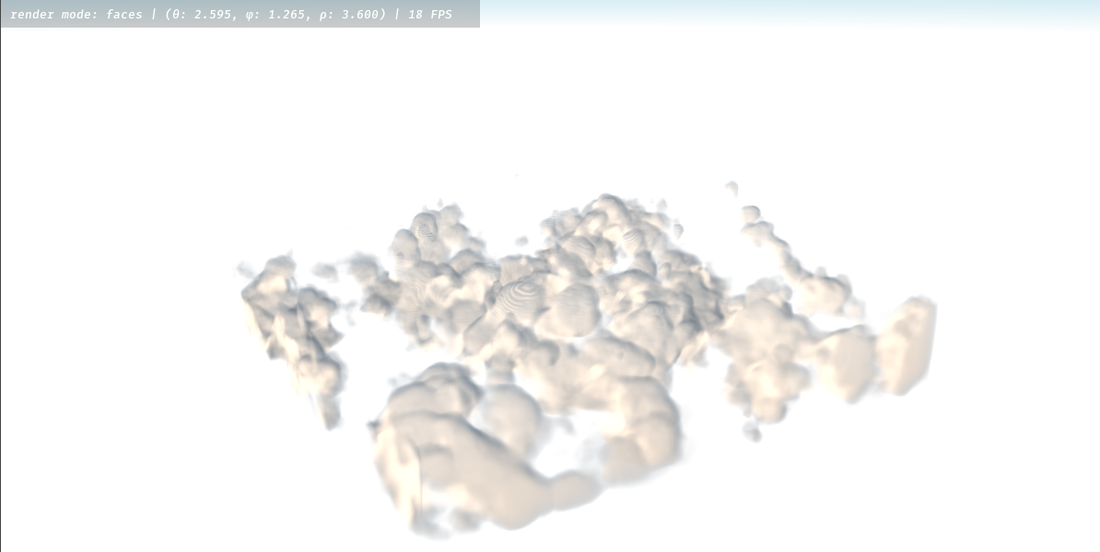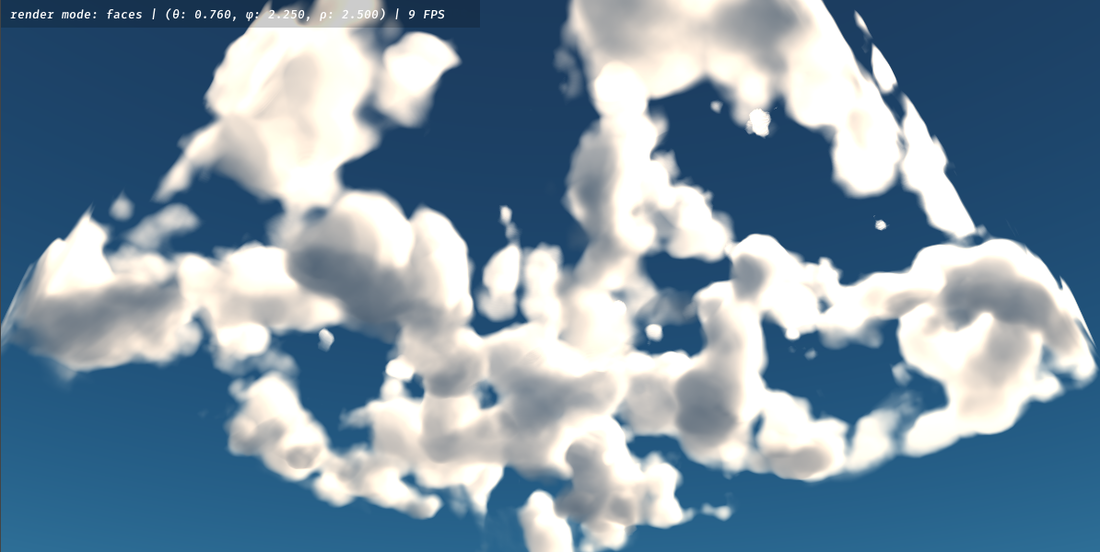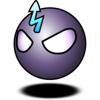Hi all,
Great work so far in this thread. I've been implementing this technique over the past little while as I've had time, and thought I would dump what I've got so far in case it helps move the discussion along. A few caveats:
- This is my first big foray into volume rendering, so I'm all but positive that some of the math is off.
- The atmospheric scattering below the clouds is completely fake and just trial and error values (you'll see in the shader what I'm doing).
- Ambient light is also just trial and error values, nothing fancy.
- My noise doesn't tile well - I get around this by using a mirrored sampler, but the downside is that the repeating pattern becomes clear pretty quickly if you looked at from the right distance.
- No temporal reprojection (yet), so performance is about what you'd expect based on the articles.
I think items 2 and 3 can be somewhat addressed by looking into the way Uncharted did some of their scattering (mip fog - basically mip map the sky box and use that as a fog lookup based on distance). FreneticPony mentioned this in Post 40. I'm hoping some of you can help me with item 1 through code review. Suggestions for item 4 are also welcome, of course.
Here's what's cooked up so far:
#include "../../ConstantBuffers/PerFrame.hlsli"
#include "../../Utils/DepthUtils.hlsli"
#include "../../Constants.hlsli"
Texture3D baseShapeLookup : register(t0);
Texture3D erosionLookup : register(t1);
Texture2D weatherLookup : register(t2);
Texture2D depthTexture : register(t3);
SamplerState texSampler : register(s0);
cbuffer cbVolumetricClouds : register(b0)
{
float3 cb_lightDirection; // light direction world space
float cb_groundRadius; // meters - for a ground/lower atmosphere only version, this could be smaller
float3 cb_sunColor; // color of sun light
uint cb_baseShapeTextureBottomMipLevel;
float cb_cloudVolumeStartHeight; // meters - height above ground level
float cb_cloudVolumeHeight; // meters - height above ground level
float cb_cloudSpeed;
float cb_cloudTopOffset;
float3 cb_windDirection;
uint cb_erosionTextureBottomMipLevel;
float3 cb_weatherTexMod; // scale(x), offset(y, z)
float cb_windStrength;
};
static const float VOLUME_END_HEIGHT = cb_cloudVolumeStartHeight + cb_cloudVolumeHeight;
// planet center (world space)
static const float3 PLANET_CENTER = float3(0.0f, -cb_groundRadius - 100.0f, 0.0f); // TODO revisit - 100.0f offset is to match planet sky settings
// radius from the planet center to the bottom of the cloud volume
static const float PLANET_CENTER_TO_LOWER_CLOUD_RADIUS = cb_groundRadius + cb_cloudVolumeStartHeight;
// radius from the planet center to the top of the cloud volume
static const float PLANET_CENTER_TO_UPPER_CLOUD_RADIUS = cb_groundRadius + VOLUME_END_HEIGHT;
static const float CLOUD_SCALE = 1.0f / VOLUME_END_HEIGHT;
static const float3 WEATHER_TEX_MOD = float3(1.0f / (VOLUME_END_HEIGHT * cb_weatherTexMod.x), cb_weatherTexMod.y, cb_weatherTexMod.z);
static const float2 WEATHER_TEX_MOVE_SPEED = float2(cb_windStrength * cb_windDirection.x, cb_windStrength * cb_windDirection.z); // this is modded by app run time
// samples based on shell thickness between inner and outer volume
static const uint2 SAMPLE_RANGE = uint2(64u, 128u);
static const float4 STRATUS_GRADIENT = float4(0.02f, 0.05f, 0.09f, 0.11f);
static const float4 STRATOCUMULUS_GRADIENT = float4(0.02f, 0.2f, 0.48f, 0.625f);
static const float4 CUMULUS_GRADIENT = float4(0.01f, 0.0625f, 0.78f, 1.0f); // these fractions would need to be altered if cumulonimbus are added to the same pass
/**
* Perform a ray-sphere intersection test.
* Returns the number of intersections in the direction of the ray (excludes intersections behind the ray origin), between 0 and 2.
* In the case of more than one intersection, the nearest point will be returned in t1.
*
* http://www.scratchapixel.com/lessons/3d-basic-rendering/minimal-ray-tracer-rendering-simple-shapes/ray-sphere-intersection
*/
uint intersectRaySphere(
float3 rayOrigin,
float3 rayDir, // must be normalized
float3 sphereCenter,
float sphereRadius,
out float2 t)
{
float3 l = rayOrigin - sphereCenter;
float a = 1.0f; // dot(rayDir, rayDir) where rayDir is normalized
float b = 2.0f * dot(rayDir, l);
float c = dot(l, l) - sphereRadius * sphereRadius;
float discriminate = b * b - 4.0f * a * c;
if(discriminate < 0.0f)
{
t.x = t.y = 0.0f;
return 0u;
}
else if(abs(discriminate) - 0.00005f <= 0.0f)
{
t.x = t.y = -0.5f * b / a;
return 1u;
}
else
{
float q = b > 0.0f ?
-0.5f * (b + sqrt(discriminate)) :
-0.5f * (b - sqrt(discriminate));
float h1 = q / a;
float h2 = c / q;
t.x = min(h1, h2);
t.y = max(h1, h2);
if(t.x < 0.0f)
{
t.x = t.y;
if(t.x < 0.0f)
{
return 0u;
}
return 1u;
}
return 2u;
}
}
float remap(
float value,
float oldMin,
float oldMax,
float newMin,
float newMax)
{
return newMin + (value - oldMin) / (oldMax - oldMin) * (newMax - newMin);
}
float3 sampleWeather(float3 pos)
{
return weatherLookup.SampleLevel(texSampler, pos.xz * WEATHER_TEX_MOD.x + WEATHER_TEX_MOD.yz + (WEATHER_TEX_MOVE_SPEED * cb_appRunTime), 0.0f).rgb;
}
float getCoverage(float3 weatherData)
{
return weatherData.r;
}
float getPrecipitation(float3 weatherData)
{
return weatherData.g;
}
float getCloudType(float3 weatherData)
{
// weather b channel tells the cloud type 0.0 = stratus, 0.5 = stratocumulus, 1.0 = cumulus
return weatherData.b;
}
float heightFraction(float3 pos)
{
return saturate((distance(pos, PLANET_CENTER) - PLANET_CENTER_TO_LOWER_CLOUD_RADIUS) / cb_cloudVolumeHeight);
}
float4 mixGradients(
float cloudType)
{
float stratus = 1.0f - saturate(cloudType * 2.0f);
float stratocumulus = 1.0f - abs(cloudType - 0.5f) * 2.0f;
float cumulus = saturate(cloudType - 0.5f) * 2.0f;
return STRATUS_GRADIENT * stratus + STRATOCUMULUS_GRADIENT * stratocumulus + CUMULUS_GRADIENT * cumulus;
}
float densityHeightGradient(
float heightFrac,
float cloudType)
{
float4 cloudGradient = mixGradients(cloudType);
return smoothstep(cloudGradient.x, cloudGradient.y, heightFrac) - smoothstep(cloudGradient.z, cloudGradient.w, heightFrac);
}
float sampleCloudDensity(
float3 pos,
float3 weatherData,
float heightFrac,
float lod)
{
pos += heightFrac * cb_windDirection * cb_cloudTopOffset;
pos += (cb_windDirection + float3(0.0f, -0.25f, 0.0f)) * cb_cloudSpeed * (cb_appRunTime/* * 25.0f*/); // the * 25.0f is just for testing to make the effect obvious
pos *= CLOUD_SCALE;
float4 lowFreqNoise = baseShapeLookup.SampleLevel(texSampler, pos, lerp(0.0f, cb_baseShapeTextureBottomMipLevel, lod));
float lowFreqFBM =
(lowFreqNoise.g * 0.625f) +
(lowFreqNoise.b * 0.25f) +
(lowFreqNoise.a * 0.125f);
float baseCloud = remap(
lowFreqNoise.r,
-(1.0f - lowFreqFBM), 1.0f, // gets about the same results just using -lowFreqFBM
0.0f, 1.0f);
float densityGradient = densityHeightGradient(heightFrac, getCloudType(weatherData));
baseCloud *= densityGradient;
float cloudCoverage = getCoverage(weatherData);
float baseCloudWithCoverage = remap(
baseCloud,
1.0f - cloudCoverage, 1.0f,
0.0f, 1.0f);
baseCloudWithCoverage *= cloudCoverage;
//// TODO add curl noise
//// pos += curlNoise.xy * (1.0f - heightFrac);
float3 highFreqNoise = erosionLookup.SampleLevel(texSampler, pos * 0.1f, lerp(0.0f, cb_erosionTextureBottomMipLevel, lod)).rgb;
float highFreqFBM =
(highFreqNoise.r * 0.625f) +
(highFreqNoise.g * 0.25f) +
(highFreqNoise.b * 0.125f);
float highFreqNoiseModifier = lerp(highFreqFBM, 1.0f - highFreqFBM, saturate(heightFrac * 10.0f));
baseCloudWithCoverage = remap(
baseCloudWithCoverage,
highFreqNoiseModifier * 0.2f, 1.0f,
0.0f, 1.0f);
return saturate(baseCloudWithCoverage);
}
struct VertexOut
{
float4 posH : SV_POSITION;
float3 viewRay : VIEWRAY;
float2 tex : TEXCOORD;
};
// random vectors on the unit sphere
static const float3 RANDOM_VECTORS[] =
{
float3( 0.38051305f, 0.92453449f, -0.02111345f),
float3(-0.50625799f, -0.03590792f, -0.86163418f),
float3(-0.32509218f, -0.94557439f, 0.01428793f),
float3( 0.09026238f, -0.27376545f, 0.95755165f),
float3( 0.28128598f, 0.42443639f, -0.86065785f),
float3(-0.16852403f, 0.14748697f, 0.97460106f)
};
static const uint LIGHT_RAY_ITERATIONS = 6u;
static const float RCP_LIGHT_RAY_ITERATIONS = 1.0f / float(LIGHT_RAY_ITERATIONS);
float beerLambert(float sampleDensity, float precipitation)
{
return exp(-sampleDensity * precipitation);
}
float powder(float sampleDensity, float lightDotEye)
{
float powd = 1.0f - exp(-sampleDensity * 2.0f);
return lerp(
1.0f,
powd,
saturate((-lightDotEye * 0.5f) + 0.5f) // [-1,1]->[0,1]
);
}
float henyeyGreenstein(
float lightDotEye,
float g)
{
float g2 = g * g;
return ((1.0f - g2) / pow((1.0f + g2 - 2.0f * g * lightDotEye), 1.5f)) * 0.25f;
}
float lightEnergy(
float lightDotEye,
float densitySample,
float originalDensity,
float precipitation)
{
return 2.0f *
beerLambert(densitySample, precipitation) *
powder(originalDensity, lightDotEye) *
lerp(henyeyGreenstein(lightDotEye, 0.8f), henyeyGreenstein(lightDotEye, -0.5f), 0.5f);
}
// TODO get from cb values - has to change as time of day changes
float3 ambientLight(float heightFrac)
{
return lerp(
float3(0.5f, 0.67f, 0.82f),
float3(1.0f, 1.0f, 1.0f),
heightFrac);
}
float sampleCloudDensityAlongCone(
float3 startPos,
float stepSize,
float lightDotEye,
float originalDensity)
{
float3 lightStep = stepSize * -cb_lightDirection;
float3 pos = startPos;
float coneRadius = 1.0f;
float coneStep = RCP_LIGHT_RAY_ITERATIONS;
float densityAlongCone = 0.0f;
float lod = 0.0f;
float lodStride = RCP_LIGHT_RAY_ITERATIONS;
float3 weatherData = 0.0f;
float rcpThickness = 1.0f / (stepSize * LIGHT_RAY_ITERATIONS);
float density = 0.0f;
for(uint i = 0u; i < LIGHT_RAY_ITERATIONS; ++i)
{
float3 conePos = pos + coneRadius * RANDOM_VECTORS[i] * float(i + 1u);
float heightFrac = heightFraction(conePos);
if(heightFrac <= 1.0f)
{
weatherData = sampleWeather(conePos);
float cloudDensity = sampleCloudDensity(
conePos,
weatherData,
heightFrac,
lod);
if(cloudDensity > 0.0f)
{
density += cloudDensity;
float transmittance = 1.0f - (density * rcpThickness);
densityAlongCone += (cloudDensity * transmittance);
}
}
pos += lightStep;
coneRadius += coneStep;
lod += lodStride;
}
// take additional step at large distance away for shadowing from other clouds
pos = pos + (lightStep * 8.0f);
weatherData = sampleWeather(pos);
float heightFrac = heightFraction(pos);
if(heightFrac <= 1.0f)
{
float cloudDensity = sampleCloudDensity(
pos,
weatherData,
heightFrac,
0.8f);
// no need to branch here since density variable is no longer used after this
density += cloudDensity;
float transmittance = 1.0f - saturate(density * rcpThickness);
densityAlongCone += (cloudDensity * transmittance);
}
return saturate(lightEnergy(
lightDotEye,
densityAlongCone,
originalDensity,
lerp(1.0f, 2.0f, getPrecipitation(weatherData))));
}
float4 traceClouds(
float3 viewDirW, // world space view direction
float3 startPos, // world space start position
float3 endPos) // world space end position
{
float3 dir = endPos - startPos;
float thickness = length(dir);
float rcpThickness = 1.0f / thickness;
uint sampleCount = lerp(SAMPLE_RANGE.x, SAMPLE_RANGE.y, saturate((thickness - cb_cloudVolumeHeight) / cb_cloudVolumeHeight));
float stepSize = thickness / float(sampleCount);
dir /= thickness;
float3 posStep = stepSize * dir;
float lightDotEye = -dot(cb_lightDirection, viewDirW);
float3 pos = startPos;
float3 weatherData = 0.0f;
float4 result = 0.0f;
float density = 0.0f;
for(uint i = 0u; i < sampleCount; ++i)
{
float heightFrac = heightFraction(pos);
weatherData = sampleWeather(pos);
float cloudDensity = sampleCloudDensity(
pos,
weatherData,
heightFrac,
0.0f);
if(cloudDensity > 0.0f)
{
density += cloudDensity;
float transmittance = 1.0f - (density * rcpThickness);
float lightDensity = sampleCloudDensityAlongCone(
pos,
stepSize,
lightDotEye,
cloudDensity);
float3 ambientBadApprox = ambientLight(heightFrac) * min(1.0f, length(cb_sunColor.rgb * 0.0125f)) * transmittance;
float4 source = float4((cb_sunColor.rgb * lightDensity) + ambientBadApprox/*+ ambientLight(heightFrac)*/, cloudDensity * transmittance); // TODO enable ambient when added to constant buffer
source.rgb *= source.a;
result = (1.0f - result.a) * source + result;
if(result.a >= 1.0f) break;
}
pos += posStep;
}
// experimental fog - may not be needed if clouds are drawn before atmosphere - would have to draw sun by itself, then clouds, then atmosphere
// fogAmt = 0 to disable
float fogAmt = 1.0f - exp(-distance(startPos, cb_eyePositionW) * 0.00001f);
float3 fogColor = float3(0.3f, 0.4f, 0.45f) * length(cb_sunColor.rgb * 0.125f) * 0.8f;
float3 sunColor = normalize(cb_sunColor.rgb) * 4.0f * length(cb_sunColor.rgb * 0.125f);
fogColor = lerp(fogColor, sunColor, pow(saturate(lightDotEye), 8.0f));
return float4(clamp(lerp(result.rgb, fogColor, fogAmt), 0.0f, 1000.0f), saturate(result.a));
}
float4 main(VertexOut pIn) : SV_TARGET
{
int3 loadIndices = int3(pIn.posH.xy, 0);
float zwDepth = depthTexture.Load(loadIndices).r;
bool depthPresent = zwDepth < 1.0f;
float depth = linearizeDepth(zwDepth);
float3 posV = pIn.viewRay * depth;
float3 posW = mul(float4(posV, 1.0f), cb_inverseViewMatrix).xyz;
float3 viewDirW = normalize(posW - cb_eyePositionW);
// find nearest planet surface point
float2 ph = 0.0f;
uint planetHits = intersectRaySphere(
cb_eyePositionW,
viewDirW,
PLANET_CENTER,
cb_groundRadius,
ph);
// find nearest inner shell point
float2 ih = 0.0f;
uint innerShellHits = intersectRaySphere(
cb_eyePositionW,
viewDirW,
PLANET_CENTER,
PLANET_CENTER_TO_LOWER_CLOUD_RADIUS,
ih);
// find nearest outer shell point
float2 oh = 0.0f;
uint outerShellHits = intersectRaySphere(
cb_eyePositionW,
viewDirW,
PLANET_CENTER,
PLANET_CENTER_TO_UPPER_CLOUD_RADIUS,
oh);
// world space ray intersections
float3 planetHitSpot = cb_eyePositionW + (viewDirW * ph.x);
float3 innerShellHit = cb_eyePositionW + (viewDirW * ih.x);
float3 outerShellHit = cb_eyePositionW + (viewDirW * oh.x);
// eye radius from planet center
float eyeRadius = distance(cb_eyePositionW, PLANET_CENTER);
if(eyeRadius < PLANET_CENTER_TO_LOWER_CLOUD_RADIUS) // under inner shell
{
// exit if there's something in front of the start of the cloud volume
if((depthPresent && (distance(posW, cb_eyePositionW) < distance(innerShellHit, cb_eyePositionW))) ||
planetHits > 0u) // shell hits are guaranteed, but the ground may be occluding cloud layer
{
return float4(0.0f, 0.0f, 0.0f, 0.0f);
}
return traceClouds(
viewDirW,
innerShellHit,
outerShellHit);
}
else if(eyeRadius > PLANET_CENTER_TO_UPPER_CLOUD_RADIUS) // over outer shell
{
// possibilities are
// 1) enter outer shell, leave inner shell
// 2) enter outer shell, leave outer shell
float3 firstShellHit = outerShellHit;
if(outerShellHits == 0u ||
depthPresent && (distance(posW, cb_eyePositionW) < distance(firstShellHit, cb_eyePositionW)))
{
return float4(0.0f, 0.0f, 0.0f, 0.0f);
}
float3 secondShellHit = outerShellHits == 2u && innerShellHits == 0u ? cb_eyePositionW + (viewDirW * oh.y) : innerShellHit;
return traceClouds(
viewDirW,
firstShellHit,
secondShellHit);
}
else // between shells
{
/*
* From a practical viewpoint (properly scaled planet, atmosphere, etc.)
* only one shell will be hit.
* Start position is always eye position.
*/
float3 shellHit = innerShellHits > 0u ? innerShellHit : outerShellHit;
// if there's something in the depth buffer that's closer, that's the end point
if(depthPresent && (distance(posW, cb_eyePositionW) < distance(shellHit, cb_eyePositionW)))
{
shellHit = posW;
}
return traceClouds(
viewDirW,
cb_eyePositionW,
shellHit);
}
}
Again, I'm sure some of the math and maybe even the general approach is off a bit, so please feel free to offer suggestions for improvement. One thing I wish was better is that the clouds don't seem to taper well as they rise with my current implementation. There may be some ideas from this thread I can use to help with that. I also need to get curl noise in, but I'm more worried about getting the general solution working well first.
If there's anything I can help out with, let me know ![]()



